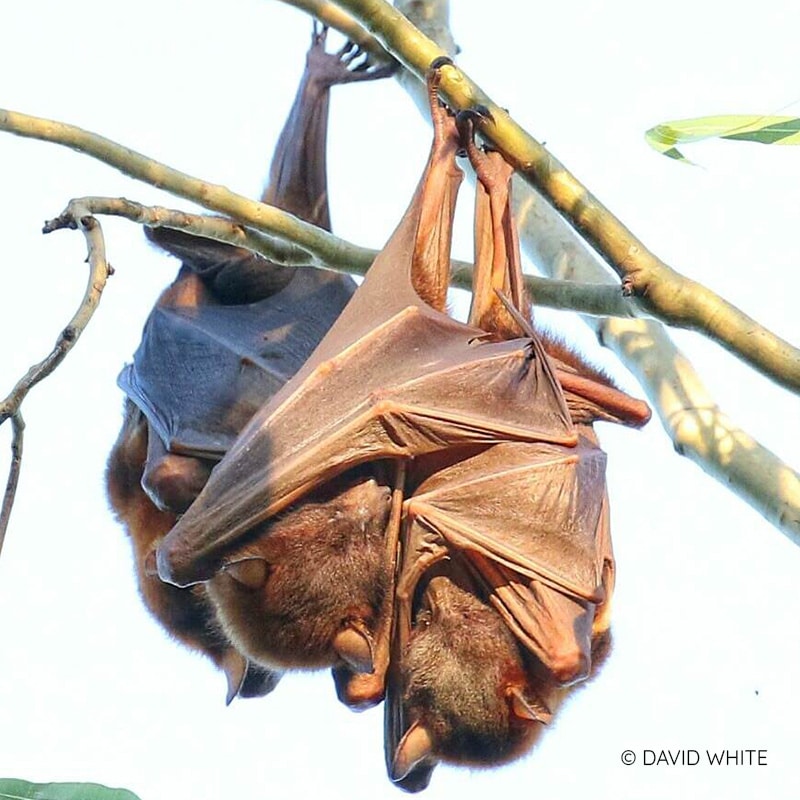Health

Bats may carry bacteria and viruses which can be harmful to humans, but the risk of infection is low. People will not be exposed to diseases when flying-foxes fly overhead, when they roost or feed in garden trees, or even from touching their droppings.
Both Hendra Virus and Australian Bat Lyssavirus are potentially fatal to humans. The relatively small number of human cases over the last 27 years became dramatic headline news, leading the public to overestimate the health risks and vilify bats as deadly.
Statistically horses, cows and dogs cause the top animal-associated human deaths every year in Australia.
Any wild animal in pain or frightened may struggle or try to bite if incorrectly handled. It is therefore recommended that if you find an injured, trapped or orphaned bat you do not attempt to help the animal yourself or touch it in any way. Contact your local wildlife organisation for assistance.
For further information see Bats and Human Health: Queensland Health
HEALTH
HENDRA VIRUS
(HeV)

Hendra virus was first identified in 1994, and is named after the Brisbane suburb in which the first outbreak occurred.
To date, there have been seven confirmed human cases of Hendra Virus. There is no known treatment, and four of the victims have died following an influenza-like illness which can progress to pneumonia or encephalitis type symptoms (brain inflammation).
All victims contracted Hendra directly from horses. There is no evidence of human-to-human transmission, or flying-fox-to-human transmission.
How is it spread?
Despite extensive research into flying-foxes and other mammals, the route of transmission to horses is still not known. The only proven route of transmission is from horses to humans.
The virus itself and every type of bodily fluid (including urine, saliva and faeces) from deliberately infected flying-foxes has been tested on horses, but scientific research was unable to successfully transfer the virus from flying-foxes to horses. The experiments did however show the virus could be transferred from cats to horses.
The findings so far suggest that flying-foxes are a natural host of Hendra virus, but spillover of the virus to horses seems to be a rare event. It is believed that the loss of habitat and natural food sources has increased the stress on the flying-fox population which in turn can trigger the manifestation of the virus.
Previously, horses infected with Hendra presented with a blood-stained mucous nasal discharge, but in later cases symptoms similar to neurological disorders and snake bite were reported. Exposure to any bodily fluids and possibly inhaling airborne mucous from sick and infected horses can transfer the virus to humans.
What can you do?
A vaccine to prevent Hendra virus infection in horses has been available since November 2012.
Until more is known about Hendra virus and its route of transmission to horses has been established, those who own or work with horses should take steps to reduce risk factors to protect themselves and the animals. Sensible precautions include avoiding contamination by ensuring feed and water dishes are away from trees where bats are known to gather, maintaining good hygiene and remaining vigilant for any symptoms that suddenly appear in a previously healthy horse.
For further information, see Hendra Virus: Queensland Health

It is important to emphasise that humans do not get hendra virus directly from flying-foxes
HEALTH
AUSTRALIAN BAT LYSSAVIRUS
(ABL)
ABL is a virus related to rabies. The symptoms and course of ABL infection is virtually identical to rabies.
When was it discovered?
It was first discovered in Australia in 1996, and there are two separate strains, one carried by flying-foxes and the other found in one species of microbat. There have been three human deaths recorded as a result of infection by ABL. One death was the result of being bitten by an infected Black Flying Fox and another was from a Yellow Bellied Sheathtail Bat.
How does it work?
The virus enters the body via a bite or scratch (and possibly, although undocumented, through mucous membranes such as eyes, mouth, nose etc). It then travels along nerve tissue to the brain where it produces severe damage and spreads to the salivary glands, from where it may be spread to the next host.
The incubation period (the time before the virus enters the nervous system) can be anything from weeks to years. Therefore, it is vital to seek medical advice even if some time has elapsed since the exposure. The second person who died from Lyssavirus was bitten two years prior to developing symptoms. The virus therefore remained dormant all that time, and had she received the vaccine her death would have been prevented. Due to the very nature of their work, bat carers and handlers are more likely to encounter infected bats and for this reason vaccinations are an essential pre-requisite prior to handling bats.

Protection and Prevention
The first thing to remember is do not touch any bat, unless you are a vaccinated bat handler. If you do get bitten or scratched by a bat, wash the site thoroughly for five minutes with soap and water, apply Betadine or another antiseptic solution to the site. You must notify your local public health unit or GP as soon as possible as you may need to receive the post-exposure vaccine which will prevent progression of the disease. Unfortunately for the animal, testing of the brain tissue is the only method to establish the presence of Lyssavirus, which requires that the animal be surrendered and euthanased.
See Australian Bat Lyssavirus: Queensland Health for further information.
